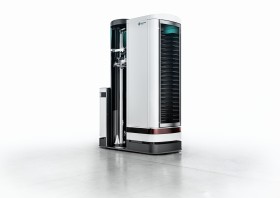
A Dexterous Warehouse Robot Does Things Amazon’s Automated Helpers Can’t
A Dexterous Warehouse Robot Does Things Amazon’s Automated Helpers Can’t
The Toru robot can take items off the shelf all by itself, which means less need for human helpers.
A German firm called Magazino believes it has built a better warehouse robot: the Toru. Unlike the robots used in Amazon warehouses that help locate items for shipping by moving entire shelves, Toru robots can pick up individual items.
“The [Amazon] approach saves a lot of human work spent on walking around, but there is still the need for a human worker to eventually pick the item off the shelf,” explains Magazino CEO and cofounder Frederik Brantner (see “Inside Amazon’s Warehouse, Human-Robot Symbiosis”).
Toru robots are particularly advantageous for orders that involve several items, Brantner says. For a four-item order, for instance, the Amazon robot might have to bring four shelves to the shipping station and then take those shelves back, for a total of eight trips. Toru can go to each of the four shelves one after the other and deliver them all to the shipping station in one trip. And there are no shelves to return.

Magazino employees create a 3-D model of each warehouse where the robots will operate. Once that map is in place, the Toru drives around the warehouse to create a 2-D map using two laser sensors that scan the environment approximately 15 centimeters above the ground. By analyzing the time it takes for the laser light to return to the sensor as it bounces off things in its path, the Toru can identify walls, columns of shelves, and human legs. This data can then be shared with other Toru robots working in the same warehouse.
“Toru is designed to navigate freely between shelves designed for humans, complementing the regular workforce, and able to operate in and around environments with high levels of uncertainty,” says Brantner.
The bots can also handle novel objects and those that are askew. After the robot approaches the correct shelf, the desired item is surveyed using lasers and cameras to determine the item’s orientation on the shelf. That data is used to determine how the gripper should grasp the object. Once the Toru has the item, it stores it in the robot’s internal shelving while it drives around the warehouse to complete the order.
Magazino makes three types of Torus, each with a different kind of item in mind. Toru Cube is used for gripping single rectangular objects. Toru Box is best for gripping standardized containers, boxes, or trays. Toru Flex can be used to pick up irregular shapes, such as an individual teddy bear from a box of bears.
The company says the robots are best suited to warehouses where employees pick individual orders, which is often the case for e-commerce warehouses. Sigloch, a book distributor in Blaufelden, Germany, uses a Toru to pick books from shelves and bring them to the shipping station. So far, five Toru robots have been sold, and an additional test run was conducted at DHL in Germany (see “A Warehouse Worker’s Best Friend—or Replacement?”).
Willy Shih, a management practice professor at Harvard Business School who specializes in technology and operations management, notes that the Amazon robots are very well suited to Amazon’s long-standing warehouse strategy of putting things wherever there’s room. Shelves are placed in any empty space while software keeps track of it all.
But Shih said he appreciates the more sophisticated approach of the Toru robot, too. “It’s using more sensing and analysis technology in terms of sizing the object and figuring out how to pick it up,” he says. He notes it’s more like a human picker. “I think it will be saving a lot of energy because it doesn’t have to move all that weight [of the shelf] around.”

Leave a Reply